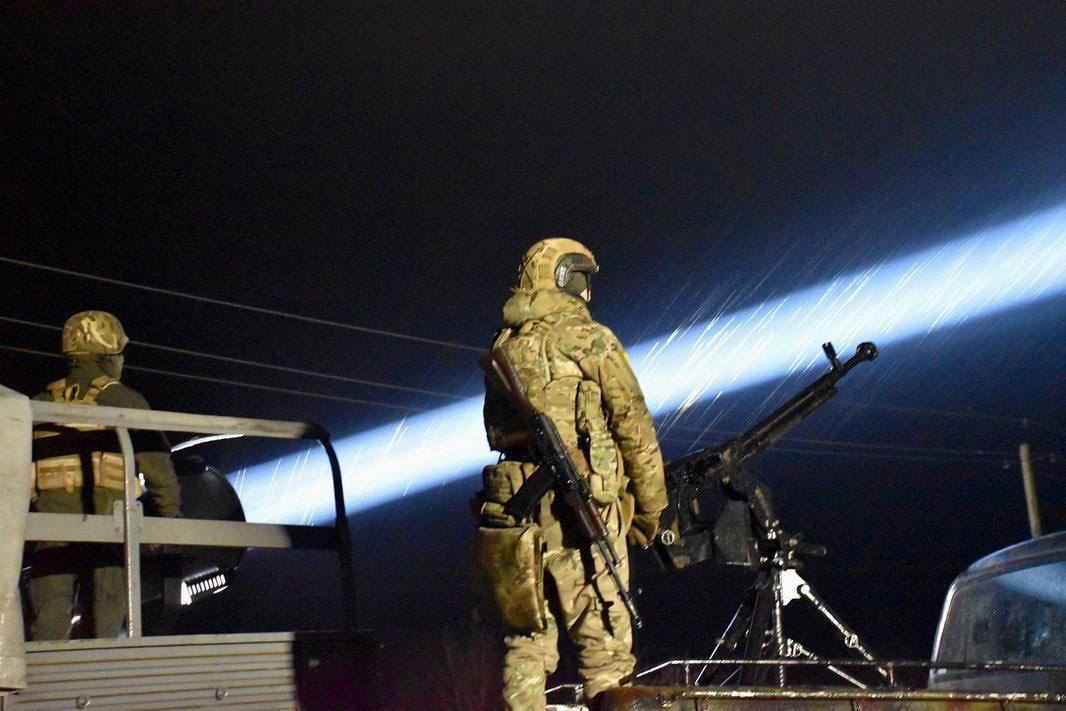Ukraine is using old-school methods of combining powerful searchlights with anti-aircraft machine guns to identify and track Russian Geran-2 kamikaze unmanned aerial vehicles (UAV).
A photo on social media showed a regular pickup truck with a DShK machine gun on the back and another truck sending out a powerful beam of searchlight into the sky.
Modern air defense radars and missiles have proven to be primarily technical and financially infeasible against cheap mass-manufactured drones.
Russia has resumed using them to strike Ukrainian military and civilian-military targets. Since September, Russia’s military has employed Iranian-made Shahed drones to hit Ukrainian targets.

EurAsian Times had previously reported another picture showing a Geran-2 with a large hole in its left wing diving towards its target. The size of the hole had led to the speculation that the drone must have taken a hit from the German-origin Gepard-2 anti-aircraft gun that fires a 35mm round.
According to Ukrainian officials, Russian forces have evolved their tactics to use kamikaze drones. Moscow had developed these by copying and tweaking Iranian-origin Shahed-136 UAVs, which it acquired a few months before the war began in February 2022.
Initially, the Russian military employed Geran-2 swarms of more than five UAVs at once to overwhelm Ukrainian air defenses. Russian forces reportedly used 12 drones for a single swarm attack in one instance.
EurAsian Times had also reported videos showing Man-Portable Air Defense (MANPAD) missiles missing approaching Gerans in simple straight line shots and the drone efficiently driving itself into the target.
Experts attributed this to the lack of infrared or electromagnetic emissions from the drones that left little for the missiles to lock on to, making them particularly deadly.
Searchlights For After-Dark Strikes?
On January 2, another Geran strike was reported in Mykolaiv, Kherson, and Dnepropetrovsk. While Russia’s sympathetic handles claimed the strikes targeted power distribution centers and electrical substations, the information could not be verified, and there were no official details on the attacks.
A clip from a close circuit television camera (CCTV) of a tall building towers above the city, time-stamped on just past midnight, showed a hail of anti-aircraft gun tracer rounds from multiple positions reaching the sky.
At one point, even what appears to be a surface-to-air missile is fired, with all these systems presumably appearing to target incoming Geran-2 drones. However, a large explosion on the ground indicates the fire missed the UAVs, and the drones made it to their target. It can be safely assumed that AA gunfire comes from DShK and Gepard systems.
Before that early morning in the intervening night of December 31 and 30, more strikes were reported in Kyiv. Footage from a personal phone camera shot from a window of a reasonably tall building showed an explosion on the ground, with the accompanying message claiming it was a Geran-2 that struck its target.
That these two videos were in midnight hours in dark skies has possibly prompted Armed Forces of Ukraine (AFU) units to use the DShK and searchlights combined systems. However, neither of these videos showed searchlights illuminating the sky, meaning it is either sparsely deployed to protect only a few key city installations or used elsewhere.
Simple Weapons For Simple Drones
This is not the first time small arms have been used for shooting down Gerans, as there was a previous video of Ukrainian police using Kalashnikov rifles, trying to hit an incoming Geran-2 last year. However, the Geran in that video continues to hit its target regardless.
Russian experts have also pointed to the noisy drone as possibly falling in the same place and injuring the person shooting from an assault rifle since the small round will merely destabilize it and not destroy it.
A New York Times (NYT) report quoted Ukrainian air force spokesperson Yurii Ihnat speaking on a radio interview that Russia has switched to launching drones at night and along the Dnieper River, making them harder to detect. “The radar antenna that detects the target will not see it if the target is flying below the level of the antenna,” he said.
The article also quoted a study by a Ukrainian consultancy Molfar, which estimated that it costs up to seven times more to down a drone with a missile than it does to launch one.
The drones cost just $20,000, while the cost of firing a SAM can range from $140,000 for a Soviet-era S-300 to $500,000 for an American National Advanced Surface-to-Air Missile System (NASAMS). Likewise, as previously discussed in the EurAsian Times, an IRIS-T missile costs about $430,000, 20 times more than the cost of the Iranian-made kamikaze drone.
While these SAM systems might be bringing down the drones and can be credited with the 60-80% kill rate that the AFU claims, they are also being expended rapidly, leaving Ukraine even more dependent on Western military and financial aid.
This has notably caused considerable weariness in the inflation-hit American and energy crises-ridden European economies. It is a different matter that this situation was brought about by Russian strikes aimed to “demilitarize” Ukraine at the beginning of the war, where it now has no functional defense industry.
Losing expensive SAM platforms to engage cheap drones might also be very well aimed at clearing Ukrainian skies for the Russian air force, which can undertake more devastating missions in its cities aimed at its military command infrastructure.
- The author can be reached at satamp@gmail.com
- Follow EurAsian Times on Google News




